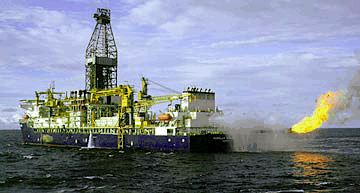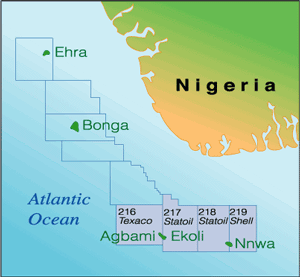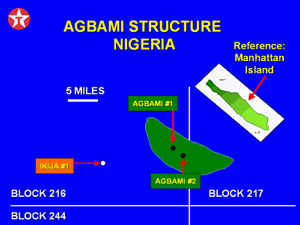Straddle fields reverse Statoil's fortunes in Nigeria

By Moses Aremu, Lagos, Nigeria
In the Nigerian offices of Den norske stats oljeselskap a.s (Statoil), where workstation rooms oversee some of the most splendid views of the Lagos Lagoon, the mood has never been so upbeat. It's the first time since it came to town seven years ago, that the Norwegian company can boast of an asset that is large enough to guarantee it's stay in Nigeria for the next 20 years.
The immediate reason for the current celebration is the Ekoli structure, in Statoil's 54% operated OPL 217. The prospect was drilled and tested from July to early October, confirming that Ekoli is an extension of the Famfa/Texaco Agbami Field, discovered in 1998 and estimated to be in excess of 1.2 billion bbl, the largest oil field in deepwater Nigeria. The well flowed 4,800 b/d in a test of one oil-bearing zone, substantially increasing the field's proven reserves.

"It's an excellent result for us", say Statoil geoscientists, looking forward to discussing a joint field development (unitization) with Famfa/Texaco. Incidentally, Texaco holds the remaining 46% of the lease 217. The discovery helps to bolster Statoil which has had more than its fair share of ill luck in Nigeria. It has significantly improved the fortunes of the company, which started brightening with the discovery of Nnwa-1,(OPL 218) another straddled field , located on the border with Shell's OPL 219, in February 1999.
For six years until then, Statoil was perhaps the most unlucky operator in deepwater West Africa. In alliance with British Petroleum, which was returning to the country after an absence of 15 years, Statoil came into Nigeria with more bounce than most other operators.
The company poached more than a dozen Nigerian geoscientists from existing major operators, moved into spacious, upscale offices, and settled down as operator of the BP/Statoil alliance. This was in contrast to Exxon, the other major new comer, which set up nothing more than a skeletal office, with just one Nigerian geoscientist, and made virtually all its thinking and decision making on its Nigerian operations—from sismic acquisition to drilling—at it's headquarters in the United States. (Amoco, another newcomer, did not take operatorship of any kind and when it merged with BP, the two companies pulled out immediately and sold their interests).
The Statoil-operated BP/Statoil alliance signed PSCs for operatorship of three leases and became technical partner in a fourth; it had interests in gross acreage spanning 8,156 square km out of which it held a net acreage 2,641sq km. These were OPL s 210 , 213, 217, and 218.

Within 24 months, Statoil drilled Nigeria's first deepwater well, Oyo-1, in OPL 210, on behalf of the operator Allied Petroleum, a Nigerian independent oil company. Oyo-1 encountered only marginal pay, even at 350 meters water depth. The next five wells were a mixture of outright dry holes and marginal oil pays. Boi-1 (OPL 213), drilled in 500 meters water depth in February 1996 encountered mere oil and gas shows. Ewo-1, the second well on behalf of Allied in OPL 210, drilled in August 1996, turned out to be bone dry. Sekhi-1, spudded in OPL 218, encountered significant gas and marginal oil pay but the company was deeply frustrated by the lack of substantial oil finds and promptly plugged and abandoned the hole. Gbigiri-1 (OPL 218) drilled in February/March 1997 and Attabila-1, drilled in September 1998 were both dry.
By the time Statoil spudded Nnwa, which turned out to be it's breakthrough well, in December 1998, its alliance partner BP had merged with Amoco and the resultant company had decided to exit deepwater Nigeria. As Statoil failed to find oil, even when Shell, Exxon, Agip, even Texaco were reporting producible discoveries, reports were rife in the Nigerian media that the company was contemplating leaving the country. Statoil reviewed its interest in four leases and gave up two(OPLs 210 and 213) to Allied and Texaco respectively. But it increased it's stake in the remaining two, OPLs 217 and 218, such that the net acreage merely dropped slightly from 2,641 to 2,405 sq km.
Still, the more hurtful situation for Statoil, was the observation within the geoscience community that the company seemed to lack an appropriate exploration strategy for finding oil in deepwater Nigeria.
"Before the Nnwa discovery of February 1999", said a source in Statoil, "we were in a shutdown mode in this country."
Nnwa-1 changed everything. Or almost did. Drilled near the Southeast corner with Shell's OPL 219, Nnwa-1 reportedly encountered 300 ft net oil in multiple pay zones. Statoil made a lot of noise about the well, but gave very scant details about the reservoirs and the specific pay zone.

With the Nnwa-1 results in mind, Shell went to drill Doro-1, in May 1999, on a location 1.5 km southeast of Nnwa-1. With Doro-1, Shell effectively tested the same structure as Nnwa and drilled the same reservoir sands. The result was a disappointing stack of gas pays in all the sands that had been reported to be oil filled in Nnwa as well as those that were yet to be properly defined. In effect, the Doro gas find downgraded the status of Nnwa and left Statoil looking bad again. With the Doro-1 results, Statoil reappraised Nnwa and reduced the field reserves from 500 million bbl to 200 million bbl oil. It was better than nothing and good enough to encourage Statoil to stay on in Nigeria.
Now with Ekoli-1, the company has erased all doubts about it's ability to win oil in deepwater Nigeria. With this well, Statoil seems to have concurred with mainstream geoscience thinking in Nigeria that the big oil sands are likely located in broad anticlines located deeper than 1,000 meters of water. Its first five wells were drilled between 350 and 800 meters water depth. They all failed to find significant oil. On the contrary, Ekoli, as well as the other major finds in deepwater Nigeria: Agbami, (Shell's) Bonga, (South Atlantic/TFE's) Akpo as well as (ExxonMobil's) Erha Fields are all located in water depths deeper than 1000 meters.
About now, Statoil is drilling another well in OPL 218. It is Bilah-1 and it is located in waters in excess of 1,400 meters depth.
